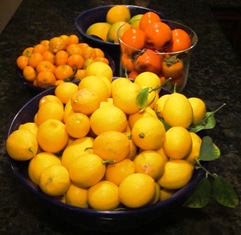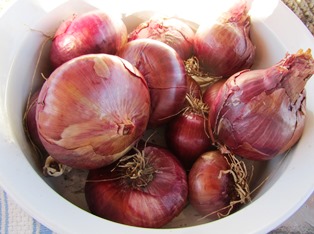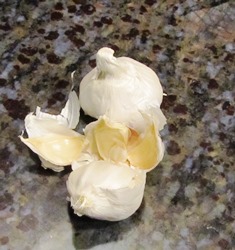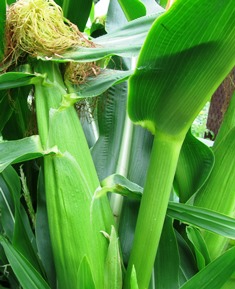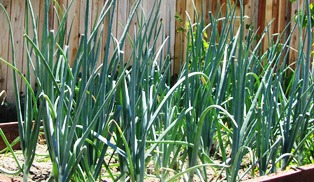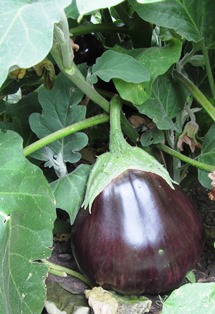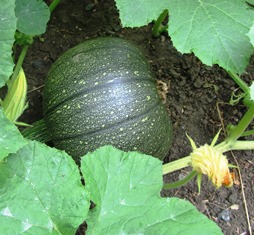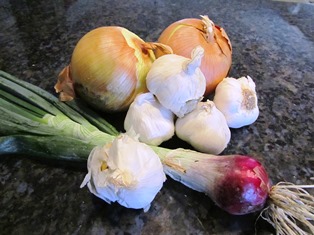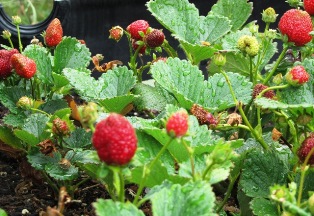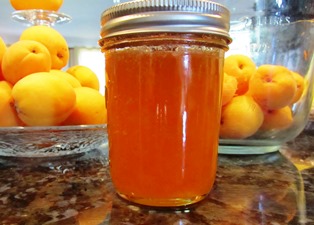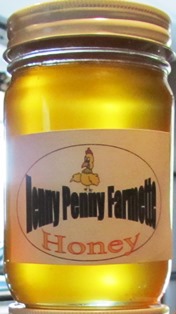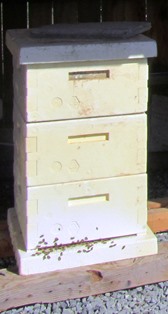Archive for the 'Health and Well-Being' Category
California’s Agricultural Wealth on Display in Its Farmers’ Markets
California is especially blessed with rich soil and that lovely Mediterranean climate with the near-perfect amount of heat and chilling that our agricultural products require.
You might not know that Northern California leads the nation in production of nearly three dozen different commodities, including artichokes, strawberries, peaches, and walnuts. Many products can be found at local farmers’ markets. See http://www.pcfma.com/
Our state offers more than 350 farmers’ markets and many are year-round. With growing interest in healthy eating as advocated by First Lady Michelle Obama, whose position about the importance of healthier food for kids and their families has been highly publicized, community participation in local farmers’ markets is growing.
Buy fresh and buy local. I love that adage because in practice your dollars spent at farmers’ markets or in direct purchases from farms preserves our farmlands, local growers, and small businesses selling locally grown fruits, vegetables, berries, nuts, and citrus.
The Pacific Coast Farmers’ Market Association has produced a comprehensive listing of agricultural products available in our area for each month of the year. I’ve recapped the list of vegetables here. The fruit and berries will be the subject of a future blog.
Asian Vegetables: January-December
Asparagus: March-June
Beans: January-December
Broccoli: January-December
Brussels sprouts: January-March; September-December
Carrots: January-December
Cauliflower: January-June; October-December
Celery: January-December
Corn: July-September
Cucumber: May-November
Eggplant: May-October
Garlic: January-December
Lettuce: January-December
Mushrooms: January-December
Onions: January-December
Parsnips: January-May; October-December
Peas: April-October
Peppers: May-November
Potatoes: January-December
Spinach: January-December
Squash (summer): May-September
Squash (winter): January-February; October-December
Sweet Potatoes: January; September-December
Tomatoes: May-October
Help preserve California’s rich heritage of plant diversity. Support your local farmers’ market by buying fresh, often just-picked vegetables and fruits, the result of our long growing season and rich soil. You’ll be supporting our state’s farmers and growers.
What’s Not to Like about Garlic?
The use of garlic (Allium sativum, an herb) was well known in the ancient world as a flavoring agent for food as well as a powerful medicinal aid. In fact, the ancients believed garlic was especially beneficial in the treatment of such maladies as indigestion, respiratory ailments, parasitic infections, and fatigue.
Modern scientific studies have shown garlic to be an effective agent in reducing blood pressure and high cholesterol. People have also used it in the treatment of tuberculosis, bronchitis, dysentery, liver ailments, diabetes, and rheumatism. Some believe garlic slows the progression of artherosclerosis (hardening of the arteries). Garlic can work like a blood thinner, and thus, it might be a valuable agent in preventing strokes and heart attacks.
Emory University School of Medicine researchers discovered that Diallyl trisulfide found in garlic oil helps to protect the heart during cardiac surgery and after a heart attack. The compound also seems to have cancer fighting properties.
Garlic kills cancer cells in test tubes. It may also lower the risk of developing colon cancer. See, http://umm.edu/health/medical/altmed/herb/garlic
A research study in China used anecdotal evidence to support the belief that eating raw garlic more than twice a week can lower the risk of getting lung cancer by 44 percent. The research was published in the journal Cancer Prevention Research.
Garlic is rich in antioxidants. Garlic oil, according to research published in the Journal of Agriculture and Food Chemistry, potentially could be used to prevent diabetes-induced cardiomyopathy, although the researchers say further study is needed. Diabetics are at higher risk for developing cardiomyopathy, a thickening of the myocardium that makes the heart become enlarged over time and less effective as a pump.
Long valued as an anti-inflammatory agent, garlic also strengthens the immune system. When taken as a prophylactic, garlic is believed to reduce the number of colds people get during the cold and flu season.
I am not a medical doctor but I believe eating a wide variety of herbs, vegetables, fruits, grains, and nuts for their nutritional value. Of course, the closer the food is to being organic and fresh, the better it will be for the body.
Garlic is easy to grow. It needs full sun, good drainage, and rich, loamy soil. In the fall, plant the cloves two inches under the soil and six inches apart clove pointed upward. Water weekly.
The cloves will grow in the spring and are ready to harvest around mid June to July, when roughly 3/4 of the top growth has turned yellow. Hang four to six weeks to cure. Keep a braid of garlic in kitchen for use in your culinary creations.
Eggstra Confusing Egg Labels
Just because an egg is organic and from a cage-free chicken does not mean the eggs are free from Salmonella Enteritidis (the bacteria that causes the foodborne illness) or that the chickens producing the eggs live free of confinement.
Supermarkets carry dozens of eggs with labels like pasteurized or organic and also free-range, cage-free, or vegetarian. Consumers can find it confusing, so here’s the low-down on eggs and their labels.
CAGE FREE
This term relates to how the chicken is confined. The chickens are not raised in cages but may be confined in barns with floors. The floors may have pine shavings or other material and the chickens will likely have nesting boxes in which to lay eggs and roosts. But cage free does not necessarily mean they have lots of space; they could be living in close confinement with many other birds, depending on the farm.
ORGANIC
In order to get the USDA certification for organic on the eggs, the chickens must not be given hormones, antibiotics, and other drugs. The hens can be caged or otherwise confined, but usually they are cage free and eat an organic diet. The USDA stipulates that to qualify as organic eggs, the layers must be fed an organic diet of grains from land deemed free from toxic chemicals and pesticide for a minimum of three years and no grain from genetically-modified crops.
FREE RANGE
Chickens considered free range are able to leave their confinement and roam freely. Depending on the farm, the birds may be under a protective covering like a canopy. This keeps the flyers from escaping and the hawks from carrying away the birds. Free-range chickens might have a richer diet, again depending on the farm, because of greater access to freely foraging on grasses, grains, and seeds.
VEGETARIAN
How, you might wonder, can a chicken be deemed vegetarian when they naturally forage for grubs and worms? They are confined in cages and fed a vegetarian diet, free of animal and fish by-products.
PASTEURIZED
The eggs containing a pasteurized label have been put through a heating process while still in their shells. For three and one-half minutes, the eggs are heated to 140 degrees Fahrenheit, thereby killing the Salmonella bacteria. Pasteurized eggs are preferable for the diet of young children, elderly people, and those who have weakened immune systems and for whom a salmonella infection might have grave consequences. Even if you don’t buy pasteurized eggs, you can eliminate the risk of Salmonella infection if you cook the egg yolk and white until firm.
SAFETY TIPS
Eggs collected from your hen house should be washed within 36 hours of being collected and immediately refrigerated at 45 degrees Fahrenheit or below. These two steps can reduce the risk of Salmonella. Refrigeration prevents the bacteria (if present) from multiplying. Eggs purchased from the store should be immediately refrigerated. And if a recipe lists a raw egg as an ingredient (for example, mayonnaise or salad dressing or cake frosting), use pasteurized eggs or egg whites.
An egg from a pasture-raised hen is much more nutritious than an egg from a large commercial enterprise, according to Mother Earth News. The publication did a study in 2007 that measured how eggs from pastured hens stack up against the USDA’s nutrient data for commercial eggs. The results suggested that eggs from the pastured chickens were nutritionally superior. For the full story, see, http://www.motherearthnews.com/real-food/tests-reveal-healthier-eggs.aspx
• 1/3 less cholesterol
• 1/4 less saturated fat
• 2/3 more vitamin A
• 2 times more omega-3 fatty acids
• 3 times more vitamin E
• 7 times more beta caroten
It might be time to acquire a few more chickens if you love eggs as much as I do, especially in those big, mid-day farm table breakfast/lunches, with fresh veggies from the garden, and homemade bread and jam.
Plunging Temperatures–The Perfect Time to Bring Out the Honey
Cold and flu season is upon us. Here in Northern California, temps are plunging into the 20s and 30s and snow may be on its way. It is important to have a strong immune system to fight off these winter maladies.

A frozen sheet of ice blocks the cork (permitting honeybees to drink) from moving in our backyard fountain
I’m taking down another jar of honey from the shelf where I stacked the jars over the summer. One teaspoon of raw buckwheat honey taken daily has been recommended by doctors as a powerful booster for the immune system. See http://www.prweb.com/releases/honey/buckwheat-honey-raw/prweb10242276.htm.
With the weather change comes the cold and flu season, so I shouldn’t have been surprised that my husband came home from work yesterday feeling out of sorts. Our neighbors have all been sick with colds and he’s concerned that he might have caught the bug.
I made him a cup of hot ginger tea, sweetened with raw honey. Honey can be consumed directly from the spoon or in hot water or in a tea or infusion with lemon.
I became a believer in honey and ginger tea years ago while studying Tai Chi. My 84-year-old teacher swore by drinking hot tea made by steeping an inch or two of fresh, peeled ginger and adding lemon and honey. Her stamina was nothing short of remarkable–she not only did Tai Chi, but sang opera, painted Chinese brush paintings, and taught many classes on herbs, reflexology, and other aspects of health and fitness in California and Hawaii.
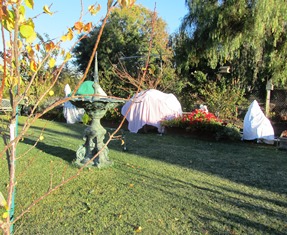
Using sheets and blankets, we’ve covered the citrus trees around our farmette as temps are expected to plunge into the 20s tonight
Holistic practitioners have long espoused belief in the healthful benefits of raw honey. Honey was used by the ancient Greeks and Romans for a variety of maladies. Modern medical doctors and researchers have extolled honey’s antiseptic, antibacterial, and anti-inflammatory properties, and many cold and flu preparations contain honey as an ingredient. It a cost-effective way to treat a cough. See http://www.mayoclinic.com/health/honey/AN01799
Honey is the only food on the planet that does not go bad. It may crystallize, but it never becomes sugar. Crystallized honey in a jar can be returned to liquid by removing the lid and setting the jar in warm water. Never heat honey in the microwave or boil it because it will destroy the natural enzymes. And never give honey to a child under the age of one year because of the risk of their developing botulism.
You don’t have to wait to start gaining the benefit of raw honey. You can strengthen your immune system now before the dreaded cold and flu sweeps through your neighborhood. Daily consumption of a teaspoon of raw honey (from flower-fed bees) that has been minimally filtered can be good for your health and, especially, your immune system.
Oats–Farm Cooking Staple Lowers Cholesterol
Steel-cut (Irish) and stone-ground (Scottish) oatmeal has a place on my pantry shelf alongside a container of quick oats. Steel cut means the groats (oat grains) get cut by a steel blade after they have been hulled. The groats of stone-ground oats are cut even smaller than the steel-cut and ground. See http://wholegrainscouncil.org/whole-grains-101/types-of-oats
In rolled oats, the groats are further flattened into flakes. But whether you eat steel-cut oatmeal that takes up to a half hour or more to cook or rolled oats that cook in minutes, you can take comfort in the fact that you are doing something good for your body.
Studies have shown that oatmeal can lower cholesterol, and lower cholesterol reduces the risk of heart disease. Steel-cut oats taste about the same as quick oats and nutritionally, the two two are also similar. See http://www.mayoclinic.com/health/cholesterol/CL00002e
Growing up n a farm, oatmeal made its way to our table on a regular basis. The women in our family also used oatmeal to create sweet treats–cookies and old fashioned deserts. Their crumbles, crisps, and betties incorporated oats in a pastry type topping laid over fruit and baked.
A crumble topping that adds oatmeal and nuts to the flour is known interchangeably as crumble or crisp. Betty is the name applied if the fruit used is an apple variety prepared with sugar, spices, and bread crumbs. The term dates to Colonial America. Sugar sweetens the crumble and butter makes it hang together in a pastry with a crumbly texture.
Here’s an example of how oatmeal might be used in a fruit crumble, crisp, or betty recipe. After sprinkling the topping onto the fruit, the dessert is baked at 375 degrees Fahrenheit for 30-35 minutes.
Ingredients for fruit filling:
6 cups cherries, apples, pears, mixed berries, or other fruit
1 cup sugar (or more, if the fruit is very tart)
1 teaspoon lemon juice (keeps the fruit from turning brown)
1 teaspoon cornstarch (use more if the fruit is very juicy and requires a thickening agent)
1 teaspoon spice such as nutmeg, ginger, or cinnamon, depending on the fruit used
Directions:
Mix fruit and ingredients together and pour into a baking dish.
Ingredients for the crumble/crisp topping:
1 cup flour
1/2 cup oats (optional)
1/2 cup chopped nuts (optional)
1/2 cup brown sugar
1/2 teaspoon baking powder
1/4 teaspoon salt
1/4 teaspoon spice (like cinnamon or ginger, depending on the type of fruit used)
1/2 cup butter (8 Tablespoons)
Directions:
Mix together the dry ingredients and cut in the butter until crumbly. Sprinkle on top of the fruit and bake for 30-35 minutes.
Herbs to Flatter Vegetables, Flavor Meat, and Finesse Fertility

If you have limited space, use taller herbs like this lavender in your landscape and gr0w smaller plants like mint in pots
Herb gardens have always held a fascination for me. One of the many reasons I love growing herbs is the scent that many herbs release with bruising that can occur when you brush against plants such as bee balm, rosemary, or lavender.
Most herbs contain fragrant oils (verbena and lavender, for example) that are frequently used in the making of cosmetics. Many herbs reseed themselves, ensuring a perennial supply for medicinal and culinary uses.
For thousands of years, herbs have been added to food to enhance the flavors. In fact, many cuisines of the world are distinctly identifiable from herbs and mixtures of them added to the food. Imagine Italian marinara without the addition of basil in the tomato sauce; a French meat or vegetable dish without savory, fennel, sorrel, rosemary, or tarragon; or an English traditional dish without bay leaf, marjoram, garlic, or mint. Consider Greek food without rosemary, thyme, or arugula.
Herbs have been used to flavor vinegar, olive oil, and liqueur. Herbs even play a role in amorous arousal. In France, Verveine du Velay is a vervain-flavored liquer popular in Le Puy. It’s reputation is further enhanced by the popular ages-old perception of it as an aphrodisiac. According to author Jade Britton (The Herbal Healing Bible, Chartwell Books, Inc.), the herbs Siberian ginseng, damiana, and saw palmetto have been used in remedies to treat male infertility along with gingko for increased blood supply to the male sex organ. See, http://www.amazon.com/The-Herbal-Healing-Bible-Traditional/dp/0785829652
While many herbs thrive in well-drained, sunny positions in the garden, others do equally well in part sun/shade. For shade-tolerant herbs, plant the following.
Chives
Cilantro/Coriander
Garlic
Lovage
Lemon Balm
Mint
Oregano
Parsley
Sweet Woodruff
Thyme
You can grow herbs in a pot, a coffee can, a half wine barrel, window box, even an old wheel barrow. The point is that herbs are not too fussy. Some are so vigorous as to be considered invasive (mint, for example). So whether you seek the enhance the flavor of food, add pizazz to a meat dish, or to increase your stamina, libido, and overall health, maybe it’s time to plant your own herb garden and see what herbs can do for you.
Garden Tuck-ins and New Plantings
From our Henny Penny Farmette organic garden, I am already harvesting tomatoes, squash, eggplant, peppers, cantaloupe, and ears of corn. But just because I’m harvesting crops now doesn’t mean I’m finished planting for the year.
In fact, in late June and July, while I am enjoying the healthy summer bounty from our garden, I like to think about what else I might plant, like more corn as a succession planting, or tucking in something new where onions or lettuces have been pulled.
In Northern California, we have the dry season (hot weather) and rainy season (cool and wet). The weather is temperate and I have learned to plant vegetables according to when they grow best.
This is the perfect time to plant beans, corn, melons, parsnips, potatoes, pumpkins, radishes, rutabaga, and turnips.
Then as the months of the fall season approach, I plan to tuck in a few cool season crops (bok choy, cabbage, carrot, fava bean, lettuces, peas, radicchio, and spinach) and root vegetables such as turnips, leeks, and onions.
Simple Strawberry Ice Cream
With fruit so abundant this time of year, the opportunities for making homemade treats are seemingly endless. I like to pick a quart or more of strawberries when they’ve ripened to make ice cream. Strawberry ice cream is a perfect treat for a Father’s Day picnic or barbecue.
This STRAWBERRY ICE CREAM recipe is simple to follow and only requires a few ingredients and a little time.
Ingredients:
1 to 2 quarts ripe strawberries
2 cups sugar
3 pints cream
pinch of salt
2 Tablespoons vanilla
Directions:
Pick, wash, and hull the strawberries.
Pass them through a course sieive, mashing and pressing the berries through the holes into a bowl.
Mix with 1 cup of sugar and set aside for one hour.
Scald the cream in a double boiler.
Add 1 cup sugar and pinch of salt to the cream to make the custard.
Remove from heat, and let cool.
Stir vanilla into the cream custard.
Fold the strawberry mixture into the custard and freeze.
Farming Prerequisite: Muscles
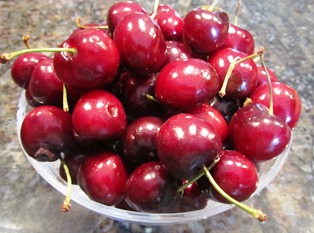
Preserving luscious stone fruit can involve hours of work, even when the process of canning is simple
Preserving the bounty of the orchard, garden, and hive is necessarily labor-intensive. The kitchen work is especially hard on the shoulders, back, and legs during stone fruit season because it requires hours of standing, washing, cutting, pitting, stirring, wiping, boiling, bottling, and labeling.
Still, I love seeing my pantry shelves stocked with jars of jam, marmalade, conserve, and honey. At last count, I’ve made (so far this season) 70 jars of apricot jam and 12 of cherry-orange conserve.
Harvesting honey from a hive is not exactly easy work either. My beekeeper neighbor and I removed a few frames of honey for ourselves in late May. From that work, this much I know: lifting a honey-filled super isn’t exactly for the faint of heart.
When the hive has a second or third super on top, lifting (not moving, just lifting) the whole shebang requires a lot of upper body strength.
Weed pulling is another job that requires muscles. This morning I weeded for a couple of hours before I’d had enough. Some weeds can grow tenacious roots up to a foot long and the roots can also have many branches. While I use a spade or shovel often as an aid to weeding, there’s something satisfying about leaning over and pulling out a weed. It’s a compulsion I share with many gardeners.
I didn’t know when I was in my twenties and off on a pilgrimage to India that the yoga I learned there and have done ever since would pay big dividends in the farm work I do today. Joint flexibility and strong muscles are absolutely necessary for the labor-intensive work of farming.
Mother’s Day Means Preparing for Stone Fruit Season
Mother’s Day marks for me the beginning of stone fruit season. The peaches, apricots, plums, and cherries will begin to ripen within a week or two. In my grandmother and mother’s kitchens in rural Missouri, the preparations for making jam began as soon as the fruit’s color changed.
I begin my search for jars, lids, rings, spoons, funnels, labels, and other canning supplies as soon as I notice that fruit color shift. I like to have everything washed, cleaned, sterilized, and organized before the fruit is ready.
This is the time, too, to organize the kitchen and storage areas. All those jars of jam will have to be stored somewhere. Right now the cottage doesn’t have much room–a little space is available beneath the cabinets off the kitchen in the bar area.
I’m thinking metal shelving could go into another area, a separate room that currently houses the water heater and furnace (turned off most of the year) since the climate is so mild.
Finally, I’ll be searching new versions of recipes for jam that go beyond the basics. I’ve added rum, spices, and vanilla bean to previous peach jams. This year, I’m interested in trying a recipe that involves the addition of smoky chipotle chilies to the jam. I’d also like to try to make a chunky blueberry-peach jam.
For my jams, I use organic fruit grown here on the farmette or purchased at my local farmers market from certified organic farms and suppliers. Using organic fruit means you can feel confident that the jam that you eat, feed your family, and give to friends is wholesome and safe to consume. What Mother’s Day breakfast tray would be complete without a luscious fruit jam?
 Facebook
Facebook Goodreads
Goodreads LinkedIn
LinkedIn Meera Lester
Meera Lester Twitter
Twitter






